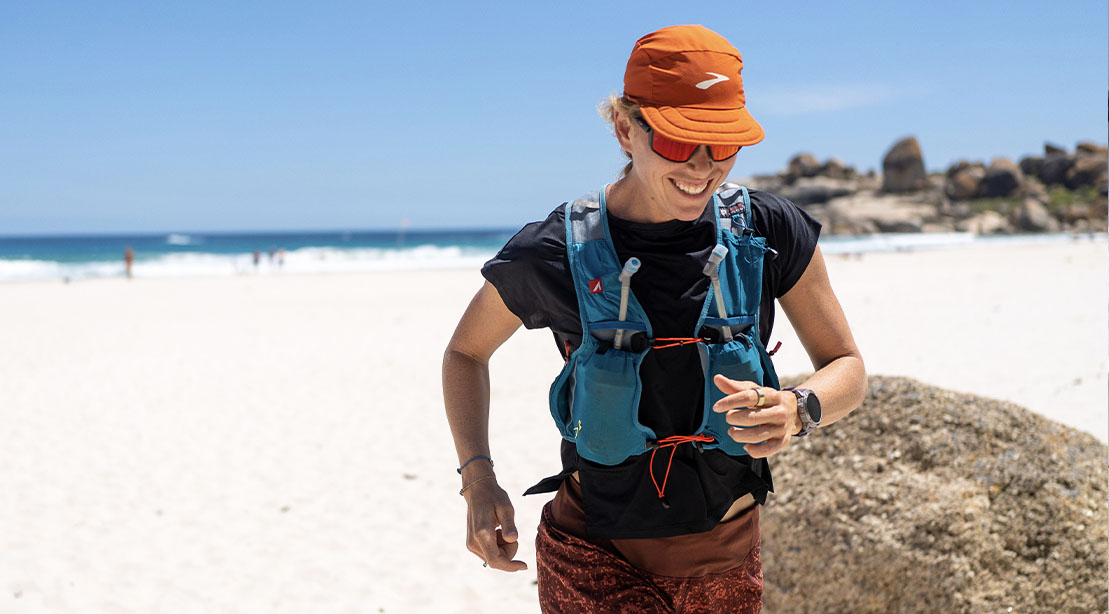When you think of trail running, rugged mountain terrain might come to mind. However, endurance athlete Hillary Allen explains trail running doesn’t necessarily mean backwoods mountains, it simply means not running on concrete (aka the road). This can look like pacing a local dirt path or park. “It’s as simple as pavement versus non-pavement,” says Allen.
For ‘trail curious’ road runners who feel intimidated to explore different terrain, this is good news. No rugged mountain paths or advanced-level terrain are required for enjoying a trail run.
With that, even experienced road runners should utilize these important trail running tips. From how to choose the best running shoe to warm-up methods, Allen sets the pace for a successful trail running season.
Can You Wear Your Road-Running Shoes for Trail Running?
If you’re out on a road run and are tempted to hit a local path, by all means, explore, however, when it comes to regular trail running, choosing a shoe designed for varying paths, such as Brooks’ Catamount 3, is the best choice. Essentially, “You need trail shoes because it helps with traction,” says Allen.
“The main difference between road and trail shoes is the outsole, (the tread underneath/part of the shoe that comes in contact with the ground) because it can provide a little bit more traction,” Allen explains and shares the outsole makes a huge difference when on the trails.
Pro Tip When Searching for a Trail Shoe
Once you find a good shoe, Allen encourages you to stick to it. “Stay with a brand that works well for your foot,” the Brooks athlete explains. “See if the brand has a trail shoe in their line, because usually if it fits your foot then that’s a good place to start.”
Good to know: According to Allen: “If you do use your trail shoe on the road (and vice versa) you won’t ruin your shoes, so to speak, but there will be some wear on certain parts of the shoe like the outsole.”
Check for ‘Hot Spots’ When Choosing Running Shoes
When choosing the right pair of running shoes, Allen suggests walking around in them in your home and noting any “hot spots.” (The shoe is either too tight, too narrow, too long, your toes touch the front of the shoe or you experience rubbing.) If you do experience hot spots, Allen warns against moving forward with the pair.
“A shoe should fit like a glove,” Allen says. “It sounds cliche, but if you’re having issues just walking around your apartment, there’s no way it’s going to do well if you’re running.”
Simply put, if your shoes feel comfortable, that’s a good first step to finding the right pair for your feet.
How Many Pairs of Running Shoes Do You Need?
Although shoes can be expensive, Allen explains the right running shoes are your best tool and that it’s important to have more than one good pair of shoes in your running rotation.
“I would say in any marathon builder, like half marathon build, you should have two shoes, even if they are the same shoe that you can rotate the runs.” Because every shoe is slightly different, rotating between two shoes can help strengthen your feet.
Don’t Sweat Your Trail Running Final Time
If you’re used to timing your road runs, the numbers may vary when on the trails as road and trail running are completely two different conditions. So expect your times to increase when hitting tougher terrain.
For example, a five-mile road run versus a five-mile trail run will produce different times, as the training surface of the trails causes one to slow down.
“Even if you’re running five miles in the park, it has more twists and turns; there might be more elevation gait up and down,’ says Allen creating a difference in time and pace.
However, a slower pace on the trails builds a stronger runner overall says Allen. Uneven terrain causes you to use a lot of stabilizer muscles you don’t use while on a singular plane. “It’s going to feel different, you might be sore, but, usually within a couple of weeks, your body will adapt,” says Allen.
“I think it just makes an overall strong runner.” My road marathon build is when I first discovered trail running and I think it actually helped me in that preparation.”
Warm Up Your Feet and Ankles Before You Hit the Trails
”Mobility and strength are a runner’s best friend,” says Allen, and stresses the importance of warming up your feet and ankles, especially before trail running.
Calf raises, (going up on your toes, and then lowering slowly down) is a great pre-trail warm-up along with ankle circles, dynamic stretching, and activation moves with bands that will wake up the muscles you’ll be using on the path.
Final Trail Running Thoughts
Trail running can help you become a stronger runner overall, increasing strength in your lower body and allowing you to become a better road runner. Utilizing both road and trail allows you to grow as a runner and discover what nature has to offer in your area.
